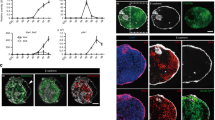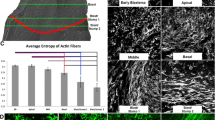Summary
The ability of day E10 mouse fore-limb bud to regulate following the removal of a portion of limb tissue was investigated. A longitudinal strip of tissue, two to three somites in width and extending from the base of the limb bud to its distal tip, was excised. The embryos were then maintained in a roller culture system for periods of 6 h, 12 h or 24 h post-operatively prior to fixation and subsequent examination. The embryos were examined with scanning electron microscopy (SEM) and light microscopy. SEM revealed that about two thirds of the operated limbs grossly restored their overall morphology. The sequence of morphological changes involved in the restoration process is described. The ability of the restored limb bud to develop an apical ectodermal ridge (AER) is shown in histological sections.
Similar content being viewed by others
References
Borgens RB (1982) Mice regrow the tips of their foretoes. Science 217:747–750
Cairns JM (1975) The function of the apical ectodermal ridge and distinctive characteristics of adjacent distal mesoderm in the avian wing-bud. J Embryo Exp Morphol 34:155–169
Carrington JL, Fallon JF (1988) Initial limb budding is independent of apical ectodermal ridge activity; evidence from a limbless mutant. Development 104:361–368
Chan WY, Lee KKH, Tam PPL (1991) The regenerative capacity of forelimb buds after amputation in mouse embryos at the early- organogenesis stage. J Exp Zool (in press)
Deuchar EM (1976) Regeneration of amputated limb-buds in early rat embryos. J Embryol Exp Morphol 35:345–354
Dhouailly D, Kieny M (1972) The capacity of the flank somatic mesoderm of early bird embryos to participate in limb development. Dev Biol 28:162–175
Fleming MW, Tassava RA (1981) Preamputation and postamputation histology of the neonatal opossum hindlimb: implications for regneration experiments. J Exp Zool 215:143–149
Fowler I, Sisken BF (1982) Effect of augmentation of nerve supply upon limb regeneration in the chick embryo. J Exp Zool 221:49–59
Gumpel-Pinot M, Ede DA, Flint OP (1984) Myogenic cell movement in the developing avian limb bud in the presence and absence of the apical ectoderm ridge (AER). J Embryol Exp Morphol 80:105–125
Illingworth CM (1974) Trapped fingers and amputated finger tips in children. J Pediatr Surg 9:853–858
Karnovsky MJ (1965) A formaldehyde-glutaraldehyde fixative of high osmolarity for use in electron microscopy. J Cell Biol 27:137a
Lowry OH, Rosenbrough NJ, Randall RJ (1951) Protein measurement with Folin reagent. J Biol Chem 193:265–275
Milaire J (1962) Histochemical aspects of limb morphogenesis in vertebrates. Adv Morphol 2:183–209
Mizell M (1968) Limb regeneration: induction in the new-born opossum. Science 161:283–285
Neufeld DA (1985) Bone healing after amputation of mouse digits and newt limbs: implication for induced regeneration in mammals. Anat Rec 211 (2):156–165
Neufeld DA (1989) Epidermis, basement membrane, and connective-tissue after amputation of mouse digits: implication for mammalian appendage regeneration. Anat Rec 223:425–432
Neufeld DA, Aulthouse AL (1986) Association of mesenchyme with attenuated basement membranes during morphogenetic stages of newt limb regeneration. Am J Anat 176 (4):411–422
Saunders JW Jr (1948) The proximo-distal sequence of origin of the parts of chick wing and the role of the ectoderm. J Exp Zool 108:363–404
Scadding SR (1982) Can differences in limb regeneration ability between amphibian species be explained by differences in quantity of innervation? J Exp Zool 219:81–85
Schotte OE, Smith CB (1961) Effects of ACTH and of cortisone upon amputational wound healing processess in mice digits. J Exp Zool 146:209–230
Summerbell D (1974) Interaction between the proximo-distal and antero-posterior coordinates of positional values during the specification of positional information in the early development of the chick limb bud. J Embryol Exp Morphol 32:227–237
Wachtler F (1984) On the migration of epidermal melanoblasts in the avian embryonic wing bud. Anat Embryol 170:307–312
Wanek N, Muneoka K, Bryant SV (1989a) Evidence for regulation following amputation and tissue grafting in the developing mouse limb. J Exp Zool 249:55–61
Wanek N, Muneoka K, Holler-Dinsmore G, Burton R, Bryant SV (1989b) A staging system for mouse limb development. J Exp Zool 249:41–49
Whittingham DG, Wales RG (1969) Storage of 2-cell mouse embryos in vitro. Aust J Biol Sci 22:1065–1068
Zwilling E (1956) Interaction between limb bud ectoderm and mesoderm in the chick embryo. J Exp Zool 32:157–171
Author information
Authors and Affiliations
Rights and permissions
About this article
Cite this article
Lee, K.K.H., Chan, W.Y. A study on the regenerative potential of partially excised mouse embryonic fore-limb bud. Anat Embryol 184, 153–157 (1991). https://doi.org/10.1007/BF00942746
Accepted:
Issue Date:
DOI: https://doi.org/10.1007/BF00942746




